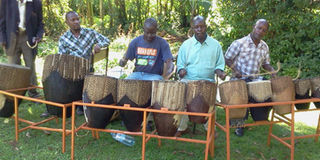Entenga: Music that soothed kings

The set of drums which are tuned like the xylophone, each with a different note to produce the Entenga. They were originally 15 in number. Photo by Edgar R. Batte
Deep in the night when his subjects had gone to sleep, the king and his drummers stayed up. At about 3am, the Entenga drums were sounded to entertain the king. These would sooth him to sleep. That was many years ago.
When historian Prof James Isabirye realised that the Entenga was on the verge of extinction, he called on Peter Gayira Jr, one of the prominent drum-makers in Bubule-Mpambire, near Mpigi District, to make him a set of the drums. Entenga are originally a set of 15 drums that were played in the palace.
Ahead of the king’s forthcoming celebrations, Isabirye and the Entenga Drums Music Performers will be one of the headlining acts at Kabasanda where the main celebrations will be held.
Singing Wells, an online platform that records, archives and shares about traditional music of East Africa, explains that Hugh Tracey, an ethnomusicologist, recorded the Entenga in the 1950s.
“And thanks to the International Library of African Music we brought his recordings with us and have repatriated the music back to Uganda. In addition, Lois Anderson recorded some performances of surviving musicians, wrote about the tradition and published transcriptions of about 26 tunes,” the website states in part.
Isabirye, a lecturer in the department of performing arts at Kyamboggo University, says the drums need to be preserved as a cultural identity of not only the Baganda but also for Uganda as a country.
Galabuzi Mukasa, a music anthropologist and Musisi Mukalazi, one of the last surviving royal instrumentalists that played in Sir Edward Muteesa II’s palace, corraborate the fact that the Entenga was a royal instrument.
Prof Isabirye explains that in the 15-drum composition, the drums are organised in order of size and pitch for the 12 drums. “The 13th drum is called Entemyo, the 14th called Kyawakati and the 15th called Nakawombe,” the music teacher explains.
Nakawombe is the most important or significant of the drums and Isabirye adds that it is not because of its size but its pitch. The names of the three drums connote depth of the Luganda language that should be of philosophical importance among Baganda as a people.
The other drums, as Isabirye notes, play an accompanying role. According to Musisi, the king in the early 1960s loved the Entenga drums so much that he asked the drummers to play every morning at 3am.
Isabirye, also founder of National Council of Folklorists of Uganda (Nacofu), collaborates this, adding that the kings always liked music as a favourite pastime, which explains why there were always musicians in the royal courts.
Mukalazi adds that the kings would stay awake in the night because this was the most peaceful time of the night so he would fully appreciate the music.
Reviving the drums
Singing Wells have backed efforts by Isabirye to revive the Entenga, observing that with few exceptions, the Entenga music largely died when the Buganda palace was attacked and destroyed on May 23-24, 1966.
The king fled, the musicians were disbanded, the drums destroyed, and the Entenga were considered dead. “That is how we felt in 2013 when we considered reviving the drums. But we thought all the drummers that had played in the palace had died,” Isabirye adds.
And then, they found Mukalazi, who was 16 when the palace was destroyed and who is largely responsible for the drums’ revival. When Isabirye met with Mukalazi, they set out together to revive the drums. They worked with John and Albert Ssempeke, and one Shaban, a professional drummer, who have kept many royal instruments alive, to re-launch the drums.
Isabirye says that in playing the drums, there are six players, each of whom has a different formal name and role in creating the music. They use curve-ended sticks to play the drums.
“Every time the drums are to be played, they are tuned,” Isabirye observes. This helps in improving their pitch output so they can distinctly be differentiated when they are sounded to produce a harmonically-beautiful sound.
The tune
These drums are tuned like the xylophone, each with a different note, following the pentatonic scale. Within the set of 12 drums, the third drum from right, the third smallest, is the home note, the ‘1’ for any key.
Initially, tuning requires endless adjustments of the ropes that tie down the drum skins. But on a minute by minute basis, the drummers are fine tuning through a combination of water on the skins and massive hits with their fists to stretch the skins.




